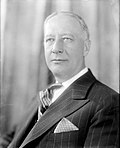This article needs additional citations for verification .(May 2023) |
| |||||||||||||||||||
| |||||||||||||||||||
 Results map by state. | |||||||||||||||||||
| |||||||||||||||||||
From March 10 to May 19, 1936, voters of the Democratic Party elected delegates to the 1936 Democratic National Convention for the purpose of selecting the party's nominee for president in the 1936 United States presidential election. [1] Incumbent President Franklin D. Roosevelt was selected as the nominee through a series of primary elections and caucuses culminating in the 1936 Democratic National Convention held from June 23 to June 27, 1936, in Philadelphia, Pennsylvania.





